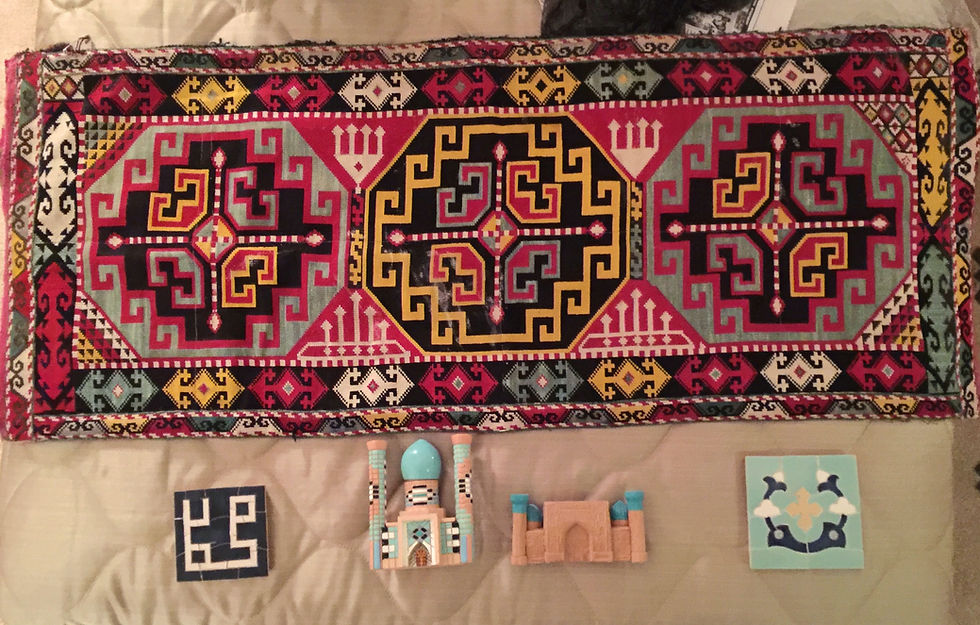Istanbul/Ethiopia/Azerbaijan Day 3
- Brian Belmont

- May 1, 2020
- 7 min read
Updated: May 24, 2020
February 27, 2016

I did actually sleep but awakened to a dream of missing my flight. I tried to go back to sleep for a bit but couldn't - 5:30am came quickly..

The shower did have hot water even though it was just a strong mist. I brushed my teeth again with the bottled water...saved just enough. I was packed and out with 10 minutes to spare.
Reception had to get up off of her pallet that she had on the floor behind the desk to check me out, Then she had to wake the driver...not an easy feet but we did leave on time.
The drive to the airport revealed large areas of standing water and even people wading through it. Upon arrival at the airport, it looked more like an African or poor Balkan bus station. There were many people on foot with what looked like all of their household goods and some animals. I don't get the last one!
I waded through the people like shopping at a bazaar, many people sleeping on the ground. At the terminal, there were three security checks to reach the gate.
I needed a boost so...a Diet Coke, the only one left in the terminal and a prober for breakfast. We were held until just before takeoff - then moved to the actual gate area. As there are no signs or anyone letting us know that boarding has commenced, I waited. Finally, I saw new people arriving and thought that I'd better ask. They were boarding. I rushed down the stairs and across the tarmac. I wasn't the last but the plane was already pretty full. I made the flight, that's all that counts.
The place was small but actually had more leg room than either flight this far.
The view of Addis Ababa from high above was one of a gritty, dirty, big city. It's the third largest in Africa.

On our way...
A flat and mostly barren land was seen between the Capitol and Gondor, a brief stop, then on to Lalibela. The landscape changed dramatically to an inhospitable land of hills and mountains one more difficult than the next. I wouldn't want to live there
The transport was waiting out front but we waited for a second plane of people before we departed.
The next 45 minutes was dirt roads, sometimes chunky and always very narrow. Dotted along the landscape were stick huts with straw roofs. There were many and as it was hot...it would allow the breeze though...clever.
Reaching The lower town we let everyone else off. The town was...bleak! Crude stalls were where you would buy everything. Donkeys and goats ruled the road...don't get in their way.
I was the last to be dropped off. This was a surprise as I was very very far from the churches and town...not as described.it was quiet and the view was nice but I would have chosen differently.
They were nice and arranged a guide for the first set of churches, today, for $30 and for the second set and a monastery for $30 tomorrow,
I had time to have lunch...crossed my fingers. I had couscous and vegetables, grown in their own garden. It was good...really good. I hoped that I'd have no problems later.
Guide showed up and soon the tuk tuk was here and up the dirty, rocky road to the Lalibala Museum which consists of the two groups of rock hewn churches. Today we saw the group closer to the entrance, the fee. ( 5 day pass ) is 1000Birr or $50. A guide can set you back $30 for each section or as much as $15 per site .
Lalibela is history and mystery frozen in stone, its soul alive with the rites and awe
of Christianity at its most ancient and unbending. No matter what you’ve heard about
Lalibela, no matter how many pictures you’ve seen of its breathtaking rock-hewn churches, nothing can prepare you for the reality of seeing it for yourself. It’s not only a World Heritage Site, but truly a world wonder.
I read this about Lalibela and being here on emphasizes how special this place is.
Lalibela, initially known as Roha, was the Zagwe dynasty’s capital in the 12th and 13th centuries. In a rare consensus, scholars and local tradition both claim that the churches date from around the time of King Lalibela (r 1181–1221). But, the consensus is thrown out the window for everything else.True believers say all work was completed in 23 years and this was possible because every night the earthly workforce was replaced by a celestial one. However, regardless of angelic masonry skills, the buildings are so different from each other in style,
artisanship and state of preservation that they surely span a far longer period than even Lalibela’s reign. It’s also unlikely they were all originally churches.
Long a victim of the usual ‘it can’t be African’ chauvinism, a few people now insist that t
he Knights of Templar were the real builders, but there’s no evidence to suggest this. In fact, exceptional masonry skills had been refined during the days of Aksum, and indeed most of t
he churches show clear Aksumite characteristics ; in particular, the doors and windows.
What a story/ legend, this is. We headed in and to the first Bet Medhane Alem, is covered by a protective tent. It's said to the the largest rock hewn church in the world. It's name means " The Savior of the World". It looks more like a Greek temple than Ethiopian Orthodox Church. It has a barrel vault and the most precise engineering imaginable. Many of the windows are crosses and the others are an Ethiopian key design.
Bet Maryam is the next large Bet. Is has one on each side but Maryam is the showpiece. It is connected by a tunnel from Medhane Alem and opens into s courtyard. It is the only with porches built off of it. It is dedicated to the Virgin Mary, who's is especially venerated here.
On its eastern wall you’ll see two sets of three windows. The upper set is thought to represent the Holy Trinity, while the lower three, set below a small cross-shaped window, are believed to represent the crucifixion of Jesus and the two sinners. The lower right window has a small opening above it, a signal that this sinner was accepted to heaven after repenting his sins and asking for Jesus’ help. The lower left window, which represents the criminal who went to hell, has the small opening below it.
Above the western porch and squeezed beneath the roof is a rare and beautifully carved bas-relief of St George fighting the dragon.Inside, the ceilings and upper walls are painted with very early frescoes, and the columns, capital and arches are covered in beautifully carved details including a curious two-headed eagle and two fighting bulls, one white, one black (thought to represent good and evil). At the eastern end of the tall nave, surrounded by seven galleries, is a holy column with inscriptions in Ge’ez, Hebrew and Greek kept permanently wrapped in cloth.
A trench at the southern end of the Bet Maryam courtyard connects it to the twin churches of Bet Golgotha and Bet Mikael (also knownas Bet Debre Sina). The pair have the only cruciform pillars of Lalibela’s churches. The entrance leads first to Bet Mikael and then to Bet Golgotha, which women can’t enter.Bet Golgotha is known for containing some of the best early examples of Ethiopian Christian art including some amazing life-size depictions of the 12 Apostles carved
into the walls’ niches. Four are visible with the other eight behind the curtains in the off-limits Selassie Chapel, one of Lalibela’s holiest sanctuaries and home to more fantasticart and also the reputed tomb of King Lalibela himself.
We walked across a land where the locals lived in traditional two story huts. Unesco saw them as significant and the government is resettling them into social housing several miles away. They are happy as some had been there for generations and also it is very far to walk for religious service. Some will only come once a week now.
I stopped for a man that was painting long narrow panels with the different symbols and stories of Lalibela. They were just my kind of art. He was painting in goat skin...whatever medium you have, right? I chose one and paid him 300 Birr.

Down a hill, across a road, and down another hill, we reached the inspiration for my journey here, Bet Giyorgis - Lalibela's masterpiece. Representing the apogee of the rock-hewn tradition, the Bet Giyorgis is the most visually perfect church of all, a 15m-high three tiered plinth in the shape of a Greek cross; a shape that required no internal pillars. Due to its exceptional preservation, it also lacks the obtrusive roofing seen over the other churches.
Inside, light flows in from the windows and illuminates the ceiling’s large crosses: beauty in simplicity. Peer over the curtain to see the maqdas’ beautiful dome. There are also two 800 year-old olive-wood boxes (one with opposing corkscrew keys) that locals believe were carved by King Lalibela himself and now hold the church’s treasures. Some of the cavities in the walls surrounding the church hold mummified corpses.
I stood above and marveled. I was seeing this with my own eyes. It was so much more than pictures can represent. The mountain backdrop made for quite the dramatic panorama. I'm so glad that I came to see this even with the great effort to get here. There is nothing that I've seen like this, in the world.
We called our tuk tuk and headed to the atm. The network/cell service/internet was down most of the day so, I had no money as the guide was paying for everything...very kind.my first attempt was unsuccessful as it wouldn't allow so much. (the hotel had to be paid in cash too) I tried again and it told me to try later. I don't give up so I tried again and for half the amount, it worked. I had the money to pay for the entrance fee, the days guide, and the art. I had some left over but still needed to get more tomorrow.
I returned to my unobstructed view of the mountains and wrote a bit about my day. I eventually was falling asleep even though it was only 6:30pm. I gave in but had a difficult time as I am not a napper. I fought getting up hoping I'd sleep through the night but finally got up at 10pm. I finished my days journal and listened to the wolves and crickets of the night.






















































































































Comments